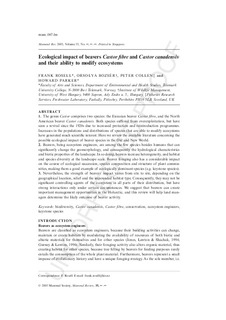Ecological impact of beavers Castor fiber and Castor canadensis and their ability to modify ecosystems
Journal article, Peer reviewed
Permanent lenke
http://hdl.handle.net/11250/2438080Utgivelsesdato
2005Metadata
Vis full innførselSamlinger
Originalversjon
Mammal review 35(2005), No. 3-4, p. 248-276 http://dx.doi.org/10.1111/j.1365-2907.2005.00067.xSammendrag
The genus Castor comprises two species: the Eurasian beaver Castor fiber, and the North American beaver Castor canadensis. Both species suffered from overexploitation, but have seen a revival since the 1920s due to increased protection and reintroduction programmes. Increases in the populations and distributions of species that are able to modify ecosystems have generated much scientific interest. Here we review the available literature concerning the possible ecological impact of beaver species in the Old and New World. Beavers, being ecosystem engineers, are among the few species besides humans that can significantly change the geomorphology, and consequently the hydrological characteristics and biotic properties of the landscape. In so doing, beavers increase heterogeneity, and habitat and species diversity at the landscape scale. Beaver foraging also has a considerable impact on the course of ecological succession, species composition and structure of plant communities, making them a good example of ecologically dominant species (e.g. keystone species). Nevertheless, the strength of beavers??impact varies from site to site, depending on the geographical location, relief and the impounded habitat type. Consequently, they may not be significant controlling agents of the ecosystem in all parts of their distribution, but have strong interactions only under certain circumstances. We suggest that beavers can create important management opportunities in the Holarctic, and this review will help land managers determine the likely outcome of beaver activity.
Beskrivelse
The definitive version is available at www.blackwell-synergy.com
